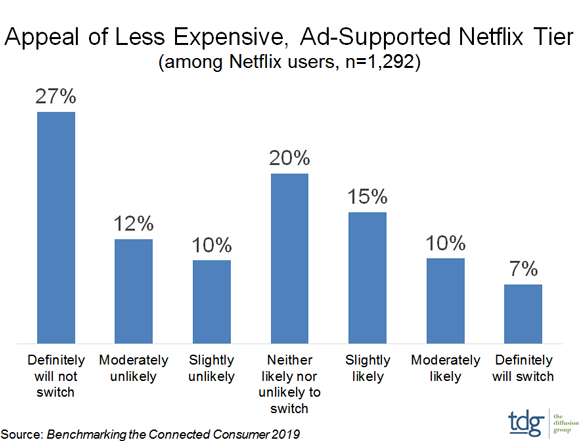
After more than 40 years of operation, DTVE is closing its doors and our website will no longer be updated daily. Thank you for all of your support.
TDG: third of Netflix subs would consider low-cost ad-supported variant
A third of Netflix US subscribers would consider switching to a less-expensive, ad-supported tier, according to research from research outfit TDG.
According to the research, a third of subscribers would consider changing tiers, over half of which are moderately likely to or definitely would switch if such an offering was available.
 According to TDG’s Benchmarking the Connected Consumer study, some 7% said they would definitely switch to an ad-supported tier, while 10% were moderately likely to and 15% said they were slightly likely to switch.
According to TDG’s Benchmarking the Connected Consumer study, some 7% said they would definitely switch to an ad-supported tier, while 10% were moderately likely to and 15% said they were slightly likely to switch.
Some 27% said they would definitely not switch to an ad-supported tier.
TDG president and SVP of screen engine/ASI Michael Greeson said that he expected the streamer to launch a less-expensive ad-supported tier within 18 months, despite Netflix’s protestations that advertising is not in its DNA.
Greeson said that Netflix will be pushed in this direction by the loss of high-value titles to the likes of Disney and WarnerMedia as they seek to restrict licensing of content in favour of their own forthcoming direct-to-consumer services.
“Netflix’s response to its thinning third-party library is to spend more on originals, which it’s gambling will keep subscribers from jumping ship. But with half or more of its most-viewed shows being owned by three studios, each of which is launching their own DTC services, how long can you convince 55-plus million US consumers that your service is worth paying a premium price, especially compared with Hulu, which offers an ad-based option, Amazon Prime Video, free with Prime) and Disney+, coming in a $6.99 a month?”said Greeson.
Greeson argues that Netflix’s choices in the face of new competition amount to further price increases or introducing ads. He cited TDG research from last year that found that Netflix’s most recent price increase strained the limit of the service’s value, even before popular third-party shows are pulled from the lineup.
The launch of new rival services has fuelled ongoing speculation about the future of Netflix’s business model. Another alternative strategy, spending more on original content to retain existing subscribers and win new customers, could strain the company’s finances still further.

